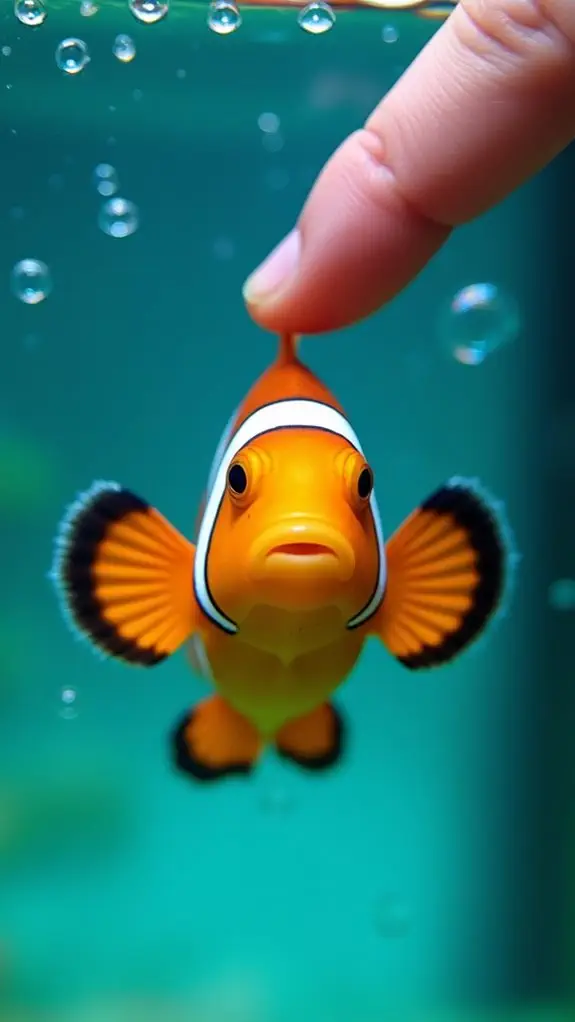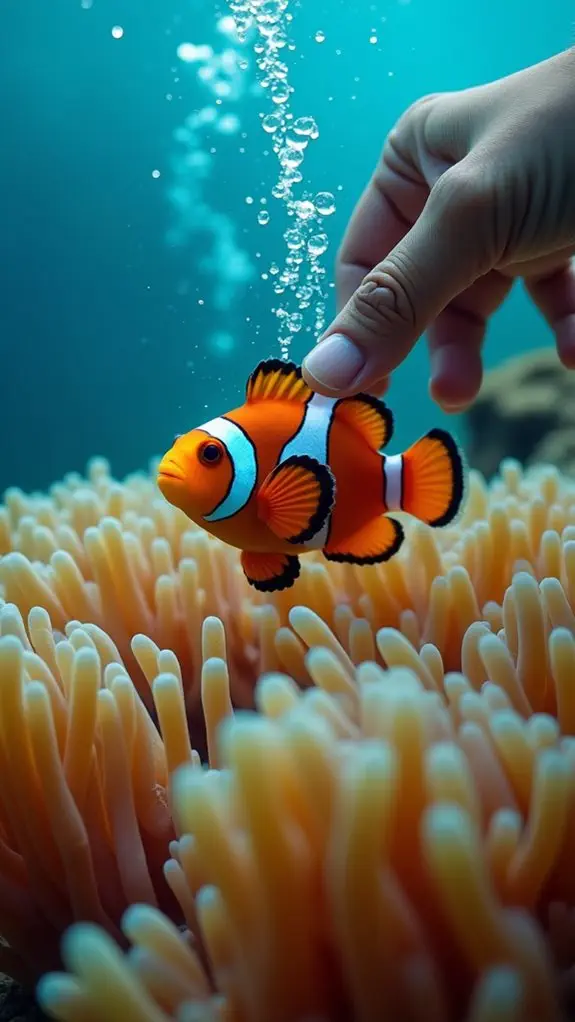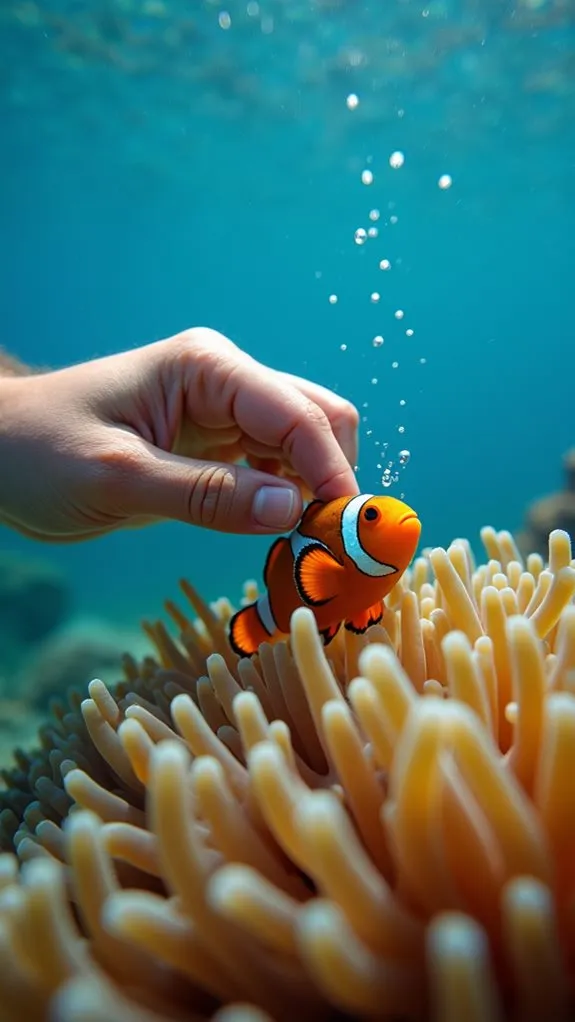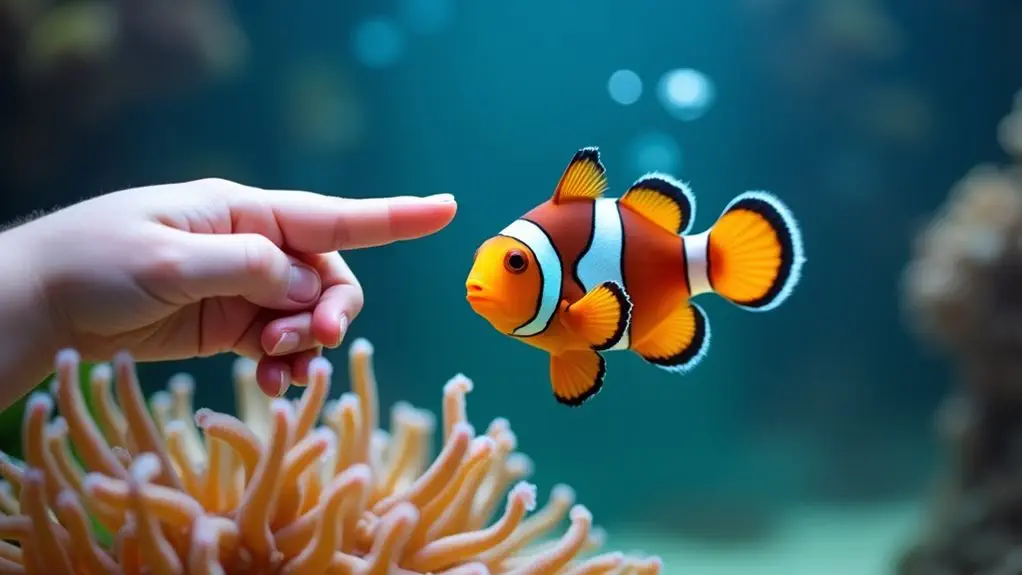Fish don't actually enjoy being touched – it's quite the opposite. When you touch a fish, you're triggering their stress response system, causing their bodies to release cortisol and making their gills more permeable to water and ions. While some species, like zebrafish and round gobies, might seek physical contact for specific purposes, it's not because they're craving pets like your cat or dog. Fish have incredibly sensitive lateral line cells that detect the slightest water movements, and physical contact can be overwhelming for their delicate sensory systems. Understanding how fish experience touch can help you interact with them more responsibly and respectfully.
Contents
- 1 The Science Behind Fish Touch
- 2 Understanding Fish Sensory Systems
- 3 How Fish Feel Physical Contact
- 4 Research on Fish Touch Responses
- 5 Fish Stress and Physical Touch
- 6 Touch Mechanisms in Different Species
- 7 Best Practices for Handling Fish
- 8 Frequently Asked Questions
- 8.1 Can Fish Recognize Their Owners Through Touch Like Dogs and Cats Do?
- 8.2 Do Fish Enjoy Being Petted More When They're Young or Adult?
- 8.3 Which Species of Pet Fish Are Most Receptive to Gentle Touching?
- 8.4 How Long Should Each Petting Session With Fish Last to Avoid Stress?
- 8.5 Can Regular Touching Help Sick or Injured Fish Recover Faster?
- 9 Final Thoughts
The Science Behind Fish Touch

The remarkable science behind fish touch reveals an intricate system of sensory perception that's more sophisticated than many realize. You might be surprised to learn that fish emotions and touch preferences aren't too different from other animals, including humans.
Through their specialized lateral line cells, fish can feel changes in water pressure and movement, much like how you might sense someone approaching from behind. Just like dairy cows are calmed by rolling brush machines, fish respond to physical sensations in similar ways. A thorough critical analysis of fish behavior patterns helps researchers better understand these responses. This understanding is crucial, as maintaining optimal water parameters in an aquarium can enhance fish well-being and reduce stress.
Research has shown that fish respond positively to certain types of touch, particularly through moving water that mimics gentle contact. When you see fish swimming through currents or rubbing against coral, they're not just playing – they're engaging in behaviors that can actually reduce their stress levels.
Scientists have found that fish exposed to these soothing movements have lower cortisol levels, indicating they're more relaxed.
What's even more fascinating is that some fish, like gobies, have fins that are as sensitive as your fingertips! They use this incredible touch sensitivity to navigate their environment, detect predators, and interact with their surroundings.
It's like having built-in underwater fingertips that help them make sense of their world.
Understanding Fish Sensory Systems
Building on what we comprehend about fish touch, their overall sensory system is even more remarkable. When you think about swimming underwater, you'll notice how different everything feels – and that's exactly why fish have developed such fascinating sensory adaptations to thrive in their aquatic environment.
You might be surprised to learn that fish have the same five basic senses we do, but they've got some impressive upgrades. Their field of vision reaches an impressive 180 degrees. They can move each eye independently (imagine having that superpower!), and they've got taste buds not just in their mouths, but all over their bodies. It's like having an entire body that can taste what's around you! These specialized taste receptors help fish with mate selection and finding food. Additionally, the ability to detect dissolved oxygen levels in the water is crucial for their survival and overall health.
What's really cool is how fish use multiple senses at once to understand their world. They've got a special lateral line system that helps them feel water movements and pressure changes, sort of like having a built-in radar system.
Their hearing works differently too – instead of outer ears like ours, they use special stones called otoliths that help them detect vibrations in the water. It's an incredibly sophisticated system that's perfectly adapted to life underwater.
How Fish Feel Physical Contact

You'll be amazed to learn that fish can feel touch just like you, with specialized nerve endings throughout their bodies and fins that detect even the slightest contact.
Their incredible lateral line system works like a built-in radar, helping them sense changes in water pressure and movement all around them.
When you're swimming near fish, they're not just seeing you – they're feeling the pressure waves you create in the water through their highly sensitive detection systems, which help them navigate their underwater world. Fish can even sense temperature variations of 0.003 degrees, allowing them to respond to the slightest changes in their environment. Research shows these sensitive systems include over 20 nociceptors in their mouths and heads, making them highly responsive to physical contact.
Touch-Sensitive Nerve Endings
Throughout their aquatic world, fish rely on remarkable touch-sensitive nerve endings to navigate and interact with their surroundings. You'll be amazed to learn that their fins aren't just for swimming – they're actually equipped with specialized cells that work similarly to the touch sensors in your own skin!
These incredible nerve endings help fish detect even the slightest changes in pressure and movement, making their touch sensitivity almost as refined as a monkey's fingertips. Their fins possess specialized neuromast cells that can detect the smallest vibrations in the water. Maintaining optimal water quality is crucial as it affects fish behavior and overall health, underscoring the importance of a healthy environment.
When you think about fish navigation, you might assume they rely solely on their eyes, but that's not the case at all. In murky waters or dark conditions, these touch-sensitive cells become their primary guides. Recent research by the University of Chicago scientists has revealed groundbreaking insights into how fish process touch sensations.
Take the catfish Pimelodus pictus, for example – it's got cells in its fins that are remarkably similar to the Merkel cells found in mammalian skin. These cells help the fish feel its way around obstacles, detect potential prey, and avoid dangers in its environment.
It's like having built-in underwater fingertips! This discovery isn't just fascinating – it's helping scientists develop better underwater robots and understand how touch sensation evolved across different species.
Lateral Line Detection Systems
Understanding fish's lateral line detection system reveals one of nature's most sophisticated touch-sensing mechanisms.
If you've ever wondered how fish navigate so gracefully through murky waters or swim in perfect synchronization, it's all thanks to this remarkable sensory adaptation.
Think of the lateral line as a fish's sixth sense – it's like having thousands of tiny fingers running along their bodies.
When you're near an aquarium, you'll notice fish responding to your movements before you even touch the glass. That's because their lateral line can detect the slightest changes in water pressure and vibrations.
Inside the lateral line, special hair cell bundles covered by a flexible cupula help process all these sensations.
It's so sensitive that they can feel a predator's approach, locate tasty snacks, and even coordinate with their schooling buddies. This incredible system can detect water movements as small as 0.03 millimeters per second.
You might be surprised to learn that this system is actually related to your own inner ear! Just as you can sense movement and balance, fish use their lateral line to create a detailed "touch map" of their surroundings.
Environmental Pressure Response
In accordance with their aquatic lifestyle, fish have developed remarkably sophisticated ways to respond to physical contact and pressure changes. Through sensory evolution, they've acquired specialized cells in their fins that work much like the touch sensors in your fingertips.
You'll be fascinated to know that these aquatic creatures can actually feel more than you might think!
When fish experience physical contact, their bodies launch into an impressive stress adaptation response. Here's what happens when a fish feels touched:
- Their gills become more permeable to water and ions
- Energy gets redirected from growth to handling the stress
- Their immune system kicks into high gear
- Cortisol levels rise to help restore their body's balance
You might notice that different fish react differently to being touched – that's because their responses vary based on their species, genetic makeup, and even their past experiences.
It's a bit like how some people love hugs while others prefer their personal space! While fish can definitely feel touch through their sensitive fin cells, it's important to remember that what might seem gentle to you could be quite stressful for them. Maintaining proper water quality is crucial, as stressed fish are more vulnerable to illnesses.
Research on Fish Touch Responses
You'll be amazed to learn that fish respond to touch in ways that are surprisingly similar to humans, with their fins containing touch-sensitive cells that work just like the ones in your fingertips.
Scientists have found that moving water can actually calm fish down, much like how a gentle touch might soothe you when you're feeling stressed.
Through detailed research on zebrafish and round gobies, we're discovering that fish don't just feel physical contact – they actively seek it out and use it to navigate their world, understand their surroundings, and even reduce their fear levels.
Neural Touch Response Patterns
Recent scientific discoveries have revealed that fish possess remarkably sophisticated touch-sensing abilities through their fins. Their neural pathways process tactile feedback in ways that are surprisingly similar to how your fingertips sense touch.
When you think about it, it's fascinating that fish fins can detect such subtle changes in their environment!
Here's what scientists have discovered about fish touch sensitivity:
- Fish fins contain specialized cells similar to the Merkel cells in your skin
- Their touch-sensing abilities can rival those of primate fingertips
- They can detect different textures and pressures with incredible precision
- Their neural responses adapt to varying speeds and patterns of touch
You'd be amazed to learn that when researchers tested fish like pictus catfish and round gobies, they found these creatures could distinguish fine details through their fins.
It's like having underwater fingertips! The neural activity patterns they've observed show that fish aren't just blindly swimming around – they're actively feeling and processing their environment.
This research isn't just fascinating; it's helping scientists develop better underwater robots and teaching us more about how fish experience their watery world.
Physical Contact Study Results
Building on our understanding of fish touch sensitivity, groundbreaking research with zebrafish has revealed fascinating insights about how physical contact affects their behavior. When scientists studied these tiny swimmers, they discovered that physical sensations, like moving water currents, actually helped reduce their fear responses and lowered their stress hormone levels.
You might be surprised to learn that fish touch preference isn't just random – it's backed by some pretty sophisticated biology. Fish behavior studies show that their fins contain specialized cells similar to what you'd find in mammalian skin, making them incredibly responsive to touch.
In fact, some species, like round gobies and catfish, have fins that are as sensitive as a primate's fingertips! These fish can detect subtle changes in texture and pressure, which helps them navigate their underwater world.
When researchers tested how fish respond to different types of physical contact, they found that gentle, predictable touch stimuli often resulted in positive responses. It's similar to how you might feel calmer when someone gives you a reassuring pat on the back – these aquatic creatures appear to experience comfort through touch too. Furthermore, maintaining clean, balanced water is essential for reducing stress in fish and enhancing their overall well-being.
Fish Stress and Physical Touch

How do fish respond to the power of touch? You might be surprised to learn that fish behavior is considerably influenced by physical contact, much like humans and other animals.
When it comes to stress management in fish, touch can actually play a calming role through their specialized lateral line cells, which help them sense movement and pressure changes in the water.
Here's what you need to know about how touch affects fish:
- Gentle water currents can soothe fish and reduce their fear responses.
- Physical touch can lower their cortisol levels, helping them feel less stressed.
- Careful handling techniques can minimize stress during necessary interactions.
- Like humans, fish respond positively to appropriate forms of touch stimulation.
Additionally, maintaining healthy water quality is crucial for ensuring fish experience minimal stress during interactions. However, it's important to remember that not all touch is beneficial. Fish can become stressed when they're handled roughly or too frequently.
They're sensitive creatures, and their well-being depends on maintaining the right balance. When you're interacting with fish, whether in an aquarium or during necessary maintenance, always use gentle movements and minimize direct contact.
This approach helps maintain your finned friends stay healthy and calm in their aquatic environment.
Touch Mechanisms in Different Species
The remarkable diversity of touch mechanisms across fish species reveals nature's ingenious solutions for underwater sensation.
You'll find that pectoral fin sensitivity varies greatly among different fish, with some species like the pictus catfish using their fins primarily for touch rather than swimming. It's fascinating how these fins work much like our own fingertips, equipped with special cells that detect even the slightest pressure or movement.
When you look at mechanosensation diversity across species, you'll notice some pretty clever adaptations.
Catfish, zebrafish, and dogfish sharks have all developed unique ways to sense their environment through touch. Even deep-sea fish, who can't rely much on vision, have evolved highly sensitive fins to help them navigate their dark world. Think of it as nature's version of having built-in underwater sensors!
These touch mechanisms aren't just random features – they're sophisticated systems that help fish survive.
Whether it's a wrasse exploring a coral reef or a stingray scanning the ocean floor, each species has fine-tuned its touch sensitivity to match its specific lifestyle and habitat needs.
Best Practices for Handling Fish

Proper handling of fish requires three essential practices: keeping them wet, minimizing air exposure, and using appropriate tools. When you're practicing the best handling techniques, remember that every second counts in ensuring the fish's survival and well-being.
Here are the most important fish care tips you'll want to follow:
- Keep your hands wet and never let the fish touch dry surfaces – this protects their critical slime coating.
- Use rubber-coated landing nets and barbless hooks to minimize injury and stress.
- Handle fish horizontally to prevent organ damage, and release them head-first.
- Identify your catch before handling to avoid unnecessary stress from multiple touches.
You'll also want to match your tackle to the size of fish you're targeting – it's like bringing a tennis racket to a ping-pong match if you don't!
Using appropriate gear helps you land fish quickly, reducing their exhaustion and stress levels. Remember, quick and gentle handling isn't just good for the fish – it's essential for their survival.
Frequently Asked Questions
Can Fish Recognize Their Owners Through Touch Like Dogs and Cats Do?
While fish can recognize you through visual and sensory perception, they don't rely on touch for owner recognition mechanisms like cats and dogs do. They primarily identify you through sight and environmental cues.
Do Fish Enjoy Being Petted More When They're Young or Adult?
You'll find it hard to compare young fish behavior and adult fish reactions to petting since there's limited scientific data. We do know both ages can show reduced fear to gentle physical contact.
Which Species of Pet Fish Are Most Receptive to Gentle Touching?
You'll find pictus catfish and flounders are most receptive to gentle contact, based on fish behavior studies. When comparing species, bottom-dwelling fish like carp and catfish generally show higher touch sensitivity through their fins.
How Long Should Each Petting Session With Fish Last to Avoid Stress?
You shouldn't exceed 20-30 seconds per petting session. Watch for stress indicators like rapid breathing or darting away. If you notice these signs, stop immediately and give your fish plenty of recovery time.
Can Regular Touching Help Sick or Injured Fish Recover Faster?
You shouldn't touch sick or injured fish as it won't provide healing benefits. Touch therapy actually increases stress and can worsen their condition. Instead, let them recover naturally in a quiet, isolated environment.
Final Thoughts
While you might want to pet a fish like you would a cat or dog, it's best to minimize handling them. Fish don't process touch the same way mammals do, and physical contact can stress them out by damaging their protective slime coating. If you need to handle your fish, you'll want to do it briefly and gently with wet hands. Remember, your scaly friends will be happiest when you appreciate them from a respectful distance.












